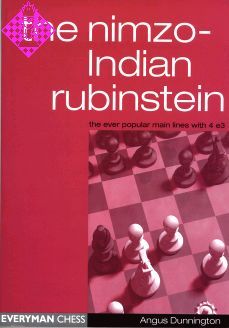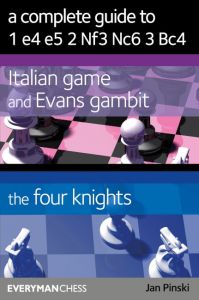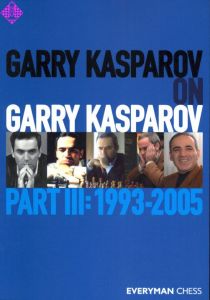The Nimzo-Indian Rubinstein
160 Seiten, kartoniert, Everyman, 1. Auflage 2004
The Nimzo-lndian Defence continues to be one of Black's most popular and respected defences to queen's pawn openings and finding an antidote for White has proved to be a difficult task for even the strongest players in the world. One of the most straightforward replies is the Rubinstein Variation (4 e3), in which White ignores Black's 'threats' and instead simply gets on with the process of developing his remaining pieces. This plan has found favour with many top players; indeed, World Champion Vladimir Kramnik used it to defeat Garry Kasparov in just 25 moves in their 2000 match in London.
In this book, renowned openings theoretician Angus Dunnington explains the ideas and strategies for both white and black players. All the major variations are covered and Dunnington brings the reader up-to-date with the ever developing theory.
- Written by a leading openings expert
- Full coverage of all the major variations
- Deals with one of the most fashionable lines of the Nimzo
Angus Dunnington is an experienced International Master who is renowned for his clear positional style of play. Dunnington is also a successful chess teacher, who has coached many of Britain's top junior players. Earlier works of his include Attacking with 1 d4 and Can you be a Positional Chess Genius?
1 d4 Nf6 2 c4 e6 3 Nc3 Bb4 4 e3
The Nimzo-Indian Defence is interesting in that after only three moves Black has developed two pieces whereas White has only the knight on c3 — and even this is pinned. Not surprisingly 'defence' is considered by many an inaccurate tag because a number of lines are quite aggressive, with Black fighting for the initiative from the off-set, and this explains why the Nimzo is popular at all levels.
Of course White can chicken out with 3 Nf3, but bringing out this knight first ignores the important e4-square (and the related d5) and is therefore not as taxing for Black. Moreover, there is no shortage of systems against the Nimzo (most players can expect to try out more than one line before hitting on a favourite), with 4 g3, 4 Qc2, 4 f3, 4 Bg5 and 4 e3, for example, all enjoying varying degrees of support over the years, each leading to different types of middlegame.
However, what sets 4 e3 apart from the rest is its flexibility — White is likely to play the sensible e2-e3 at some point in the early stage of the opening and doing so here leaves Black in the dark as to what piece configuration is to come. Black, for his part, is given the opportunity to steer the game some way down a direction of his own choosing. Consequently both sides tend to find themselves — more than once — being able to influence the progression of the game, and it is this fluidity that makes for an abundance of what I would call 'real' positions in which an understanding of key concepts and an appreciation of the relationship between pawns and pieces play a more significant role than is the case in some of the more well defined, restrictive opening systems such as the Stonewall Dutch or Advance French, for example.
It is a (sad) fact of chess life these days that, despite the fact that chess is a game which should essentially be fun, we know that computer databases, analysis modules, magazine articles, books and so on are part of the opponent's armoury and considered a must if any degree of competitive success is to be hoped for (and we are trying to win, after all). With this in mind I have endeavoured to provide coverage, in some detail, of what I consider to be the more important lines available to both sides. As usual I have concentrated also on important positional and structural factors as well as those themes which connect certain aspects of the opening to relevant issues in the middlegame and beyond. This is because — as those of you familiar with my other books will be well aware - I believe it is imperative that we contemplate, study and become well acquainted with the fundamentally key problem of how to play decent chess, regardless of the specific subject matter in front of us. Therefore for a 'fool-proof repertoire you should use this book in conjunction with other sources of information. White players, for instance, will not find 4...Nc6 or other lesser 4th move alternatives for Black in these pages, but I am confident that playing through the examples will set you up well for a deeper understanding of the popular, conventional situations that arise — an approach that has proved useful thus far.
Before diving in, here is a brief layout of what follows, the book being split up into three parts, dealing with 4...b6, 4...c5 and 4...0-0 (with an early ...d7-d5) respectively.
With 4...b6 Black should remember not to automatically follow up with the fianchetto in the event of 5 Ne2 as the c4-pawn provides an early target — hence 5...Ba6 as the main choice. White tends to be invited to advance in the centre in these lines, Black's initial push of the b-pawn in a way announcing that pieces rather than pawns will be used to monitor the centre.
After the more conventional Bd3 and 4 Nf 3 the e4-square is obviously important, so ...Bb7 fits in. Again Black prefers to use pieces rather than pawns in the centre, but it is possible to simply stake a claim with ...d7-d5, when Black must be prepared to see his bishop's view obscured after c4xd5 e6xd5.
4...c5 is quite different and can itself lead to varied play as the middlegame approaches, depending on how White reacts on his fifth move. After 4 Ne2 the layout in the centre can take more than one form. For example 5...cxd4 6 exd4 d5 7 a3 Bxc3+ 8 bxc3 dxc4 leaves White with the IQP, while dropping the bishop back with 7.. Be7 invites 8 c5. White also has 7 c5, when the d4-pawn is then backward (and isolated after ...b7-b6, c5xb6), but the idea is to adopt a space-gaining, clamping approach.
This time (4...c5) 5 Bd3 Nc6 6 Nf3 Bxc3+ 7 bxc3 d6 (Hubner Variation) produces an entirely different flavour in the centre. Black hopes to exploit the blocked centre that results from 8 e4 e5 9 d5 with the extra knight, a situation White can avoid by holding back his pawns in order to maintain the tension and leave the position more open. Of course structural considerations must be taken into account whatever the opening, but the various plans and choices available to both sides after 4...c5 give such factors greater significance here than with the more predictable 4...b6 lines.
Part 3 deals with 4...0-0 followed by a quick ...d7-d5. Once again 5 Ne2 is an option that, albeit ostensibly over-cautious, is bound to gain in popularity. Then 5...d5 looks sensible, planting the pawn in the centre, and this is also logical in the case of 5 Bd3 d5. Here 6 Ne2 is tidy, White settling for an IQP position (e.g. 6...c5 7 cxd5 cxd4 8 exd4 N xd5) with c3 offered extra support but with less control over e5. To many players White's king's knight belongs on f3, where it is a little more actively placed. Apart from this development being more popular, it is also seen more often because the typical positions can be reached via numerous move orders and openings (which is not the case with Ne2). Speaking of transpositions, we should not forget that these can be expected in several lines, particularly between Parts 2 & 3, where both ...c7-c5 and ...d7-d5 can feature.
Anyway, returning to Bd3 and Nf3, White must be prepared in these ...d7-d5 lines when not concerning himself with c3 to see his centre change from, for example, an IQP (after ...c5xd4, e3xd4) to the pawn duo on c3 and d4 after ...Bxc3, b2xc3. Then c3 can become a new target, as well as the c4-square, while after c3-c4 the 'hanging' pawns on c4 and d4 can
take on a rather menacing air. Finally, the 'main' line sees Black holding back the c5-pawn so that ...Bxc3 combined with ...d5xc4 leaves c3-d4-e3 for White and c5 and e6 for Black, a subsequent e3-e4 and ...e6-e5 mounting the tension in the centre.
The recurring themes throughout are structure and the centre, with emphasis on several key squares. Both sides have the facility to take the game in this or that direction, and it is by no means unusual to approach the same variation from a different perspective from game to
game.
Incidentally I suggest using one chess set to keep a track of the moves and another with which to analyse, while over recent years some of the more dedicated readers have told me that they key everything into ChessBase. Anyway, whichever side of the board you intend to be sitting on, I hope that you both enjoy and leam from the games that follow...
Angus Dunnington, October 2003
The Nimzo-lndian Defence continues to be one of Black's most popular and respected defences to queen's pawn openings and finding an antidote for White has proved to be a difficult task for even the strongest players in the world. One of the most straightforward replies is the Rubinstein Variation (4 e3), in which White ignores Black's 'threats' and instead simply gets on with the process of developing his remaining pieces. This plan has found favour with many top players; indeed, World Champion Vladimir Kramnik used it to defeat Garry Kasparov in just 25 moves in their 2000 match in London.
In this book, renowned openings theoretician Angus Dunnington explains the ideas and strategies for both white and black players. All the major variations are covered and Dunnington brings the reader up-to-date with the ever developing theory.
- Written by a leading openings expert
- Full coverage of all the major variations
- Deals with one of the most fashionable lines of the Nimzo
Angus Dunnington is an experienced International Master who is renowned for his clear positional style of play. Dunnington is also a successful chess teacher, who has coached many of Britain's top junior players. Earlier works of his include Attacking with 1 d4 and Can you be a Positional Chess Genius?
1 d4 Nf6 2 c4 e6 3 Nc3 Bb4 4 e3
The Nimzo-Indian Defence is interesting in that after only three moves Black has developed two pieces whereas White has only the knight on c3 — and even this is pinned. Not surprisingly 'defence' is considered by many an inaccurate tag because a number of lines are quite aggressive, with Black fighting for the initiative from the off-set, and this explains why the Nimzo is popular at all levels.
Of course White can chicken out with 3 Nf3, but bringing out this knight first ignores the important e4-square (and the related d5) and is therefore not as taxing for Black. Moreover, there is no shortage of systems against the Nimzo (most players can expect to try out more than one line before hitting on a favourite), with 4 g3, 4 Qc2, 4 f3, 4 Bg5 and 4 e3, for example, all enjoying varying degrees of support over the years, each leading to different types of middlegame.
However, what sets 4 e3 apart from the rest is its flexibility — White is likely to play the sensible e2-e3 at some point in the early stage of the opening and doing so here leaves Black in the dark as to what piece configuration is to come. Black, for his part, is given the opportunity to steer the game some way down a direction of his own choosing. Consequently both sides tend to find themselves — more than once — being able to influence the progression of the game, and it is this fluidity that makes for an abundance of what I would call 'real' positions in which an understanding of key concepts and an appreciation of the relationship between pawns and pieces play a more significant role than is the case in some of the more well defined, restrictive opening systems such as the Stonewall Dutch or Advance French, for example.
It is a (sad) fact of chess life these days that, despite the fact that chess is a game which should essentially be fun, we know that computer databases, analysis modules, magazine articles, books and so on are part of the opponent's armoury and considered a must if any degree of competitive success is to be hoped for (and we are trying to win, after all). With this in mind I have endeavoured to provide coverage, in some detail, of what I consider to be the more important lines available to both sides. As usual I have concentrated also on important positional and structural factors as well as those themes which connect certain aspects of the opening to relevant issues in the middlegame and beyond. This is because — as those of you familiar with my other books will be well aware - I believe it is imperative that we contemplate, study and become well acquainted with the fundamentally key problem of how to play decent chess, regardless of the specific subject matter in front of us. Therefore for a 'fool-proof repertoire you should use this book in conjunction with other sources of information. White players, for instance, will not find 4...Nc6 or other lesser 4th move alternatives for Black in these pages, but I am confident that playing through the examples will set you up well for a deeper understanding of the popular, conventional situations that arise — an approach that has proved useful thus far.
Before diving in, here is a brief layout of what follows, the book being split up into three parts, dealing with 4...b6, 4...c5 and 4...0-0 (with an early ...d7-d5) respectively.
With 4...b6 Black should remember not to automatically follow up with the fianchetto in the event of 5 Ne2 as the c4-pawn provides an early target — hence 5...Ba6 as the main choice. White tends to be invited to advance in the centre in these lines, Black's initial push of the b-pawn in a way announcing that pieces rather than pawns will be used to monitor the centre.
After the more conventional Bd3 and 4 Nf 3 the e4-square is obviously important, so ...Bb7 fits in. Again Black prefers to use pieces rather than pawns in the centre, but it is possible to simply stake a claim with ...d7-d5, when Black must be prepared to see his bishop's view obscured after c4xd5 e6xd5.
4...c5 is quite different and can itself lead to varied play as the middlegame approaches, depending on how White reacts on his fifth move. After 4 Ne2 the layout in the centre can take more than one form. For example 5...cxd4 6 exd4 d5 7 a3 Bxc3+ 8 bxc3 dxc4 leaves White with the IQP, while dropping the bishop back with 7.. Be7 invites 8 c5. White also has 7 c5, when the d4-pawn is then backward (and isolated after ...b7-b6, c5xb6), but the idea is to adopt a space-gaining, clamping approach.
This time (4...c5) 5 Bd3 Nc6 6 Nf3 Bxc3+ 7 bxc3 d6 (Hubner Variation) produces an entirely different flavour in the centre. Black hopes to exploit the blocked centre that results from 8 e4 e5 9 d5 with the extra knight, a situation White can avoid by holding back his pawns in order to maintain the tension and leave the position more open. Of course structural considerations must be taken into account whatever the opening, but the various plans and choices available to both sides after 4...c5 give such factors greater significance here than with the more predictable 4...b6 lines.
Part 3 deals with 4...0-0 followed by a quick ...d7-d5. Once again 5 Ne2 is an option that, albeit ostensibly over-cautious, is bound to gain in popularity. Then 5...d5 looks sensible, planting the pawn in the centre, and this is also logical in the case of 5 Bd3 d5. Here 6 Ne2 is tidy, White settling for an IQP position (e.g. 6...c5 7 cxd5 cxd4 8 exd4 N xd5) with c3 offered extra support but with less control over e5. To many players White's king's knight belongs on f3, where it is a little more actively placed. Apart from this development being more popular, it is also seen more often because the typical positions can be reached via numerous move orders and openings (which is not the case with Ne2). Speaking of transpositions, we should not forget that these can be expected in several lines, particularly between Parts 2 & 3, where both ...c7-c5 and ...d7-d5 can feature.
Anyway, returning to Bd3 and Nf3, White must be prepared in these ...d7-d5 lines when not concerning himself with c3 to see his centre change from, for example, an IQP (after ...c5xd4, e3xd4) to the pawn duo on c3 and d4 after ...Bxc3, b2xc3. Then c3 can become a new target, as well as the c4-square, while after c3-c4 the 'hanging' pawns on c4 and d4 can
take on a rather menacing air. Finally, the 'main' line sees Black holding back the c5-pawn so that ...Bxc3 combined with ...d5xc4 leaves c3-d4-e3 for White and c5 and e6 for Black, a subsequent e3-e4 and ...e6-e5 mounting the tension in the centre.
The recurring themes throughout are structure and the centre, with emphasis on several key squares. Both sides have the facility to take the game in this or that direction, and it is by no means unusual to approach the same variation from a different perspective from game to
game.
Incidentally I suggest using one chess set to keep a track of the moves and another with which to analyse, while over recent years some of the more dedicated readers have told me that they key everything into ChessBase. Anyway, whichever side of the board you intend to be sitting on, I hope that you both enjoy and leam from the games that follow...
Angus Dunnington, October 2003
| Gewicht | 250 g |
|---|---|
| Hersteller | Everyman |
| Breite | 15,6 cm |
| Höhe | 23,4 cm |
| Medium | Buch |
| Erscheinungsjahr | 2004 |
| Autor | Angus Dunnington |
| Sprache | Englisch |
| Auflage | 1 |
| ISBN-10 | 1857442792 |
| ISBN-13 | 9781857442793 |
| Seiten | 160 |
| Einband | kartoniert |
004 Bibliography
005 Introduction
1 d4 Nf6 2 c4 e6 3 Nc3 Bb4 4 e3
Part One: 4... b6
008 1 4... b6: White Plays 5 Ne2
035 2 4... b6: White Plays 5 Bd3 and Nf3
Part Two: 4... c5
074 3 4... c5: White Plays 5 Ne2
106 4 4... c5: White Plays 5 Bd3 - The Hübner Variation
Part Three: 4... 0-0 (Planning ...d5)
126 5 4... 0-0: White Plays 5 Ne2
135 6 4... 0-0: White Plays 5 Bd3 and Ne2
144 7 4... 0-0: White Plays 5 Bd3 and Nf3
158 Index of Variations
160 Index of Complete Games
Wenn Sie mehr über die Rubinstein-Variante nach 1.d4 Sf6 2.c4 e6 3.Sc3 Lb4 4.e3 erfahren möchten, dann sind Sie hier richtig. Die schwarzen Alternativen 4...b6, 4...c5 und 4...0-0 (mit dem Plan ...d7-d5) werden sorgfältig und umfassend analysiert. Mit 28 Beispielpartien können Sie Ihre strategischen und taktischen Ideen in diesen Varianten vertiefen.
Jerzy Konikowski, Fernschach International 2/2006
__________________
In der Nimzowitsch-Indischen Verteidigung 1. d4 Sf6 2. c4 e6 3. Sc3 Lb4 hat Weiß im vierten Zug eine große Auswahl. Mit 4. e3 entsteht das Rubinstein-System, das im vorliegenden Buch behandelt wird.
Angus Dunnington bietet eine Fülle an Material, ist so aktuell wie man in einem Buch sein kann und hat den ganzen Stoff didaktisch sehr gut aufbereitet. Man sollte aber vielleicht wissen, dass er die alte Hauptvariante 4. ... 0-0 5. Ld3 d5 6. Sf3 c5 7. 0-0 Sc6 8. a3 Lxc3 9. bxc3 dxc4 10. Lxc4 Dc7 für überholt hält und entsprechend kurz abhandelt. Wer sich daran nicht stört, ist mit dem Buch sehr gut bedient.
____________________
In der Nimzoindischen Verteidigung kämpft Schwarz von Anfang an um die Initiative, asymmetrische Stellungen entstehen, in denen der Spieler mit dem größeren positionellen Verständnis eher als in anderen Eröffnungen den Punkt einfahren wird. 4.e3 ist der flexibelste weiße Zug, der eigentlich immer Sinn macht.
IM Dunnington konzentriert sich auf die Hauptvarianten und das Verständnis der Schlüsselkonzepte. Dadurch lässt er natürlich die eine oder andere Variante aus, so fehlen z.B. 4...Sc6, 4...d6 oder (die wichtigere Variante) 4...c5 5.Se2 b6.
Die Theorie der Varianten nach 4...b6, 4...c5 und 4...0-0 wird, wie bei Everyman üblich, an Hand von Partien behandelt. Im the nimzo-indian rubinstein sind es deren leider nur insgesamt 18, was dazu führt, dass eine Anmerkung schon einmal drei Seiten lang werden kann. Optisch übersichtlicher wäre es sicher gewesen, wenn man die Anzahl der Partien etwas erhöht hätte.
Die einzelnen Varianten lassen sich über den zweiseitigen Variantenindex relativ schnell und einfach ermitteln.
Die Bibliographie hingegen überrascht durch ihre Übersichtlichkeit. Es sind dort nämlich nur drei Einträge aufgeführt: ECO, NCO und FM Carsten Hansens "The Nimzo-Indian 4.e3". Das letztere Werk ist dabei mit 320 Seiten zum selben Thema deutlich umfangreicher, konzentriert sich aber dabei auf die Theorievarianten und nicht so sehr auf deren Erläuterung. Dunnington dagegen bemüht sich um eine knappe, übersichtliche und objektive Darstellung der Hauptvarianten nach 4.e3, ergänzt um ausführliche Erläuterungen, die das Verständnis des Lesers erhöhen sollen. Somit ist the nimzo-indian rubinstein sehr gut zum Einstieg in diese schwierige Variante geeignet. Für hochklassige Spieler ist allerdings das o.a. Werk von Hansen zur Ergänzung angeraten.
Thomas Schian - Rochade Europa 7/2004
-
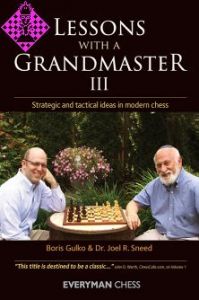 Lessons with a Grandmaster III20,50 €
Lessons with a Grandmaster III20,50 € -
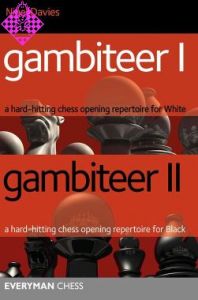 Gambiteer23,50 €
Gambiteer23,50 € -
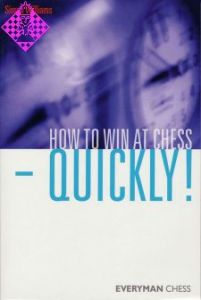 How to Win at Chess - Quickly !19,95 €
How to Win at Chess - Quickly !19,95 € -
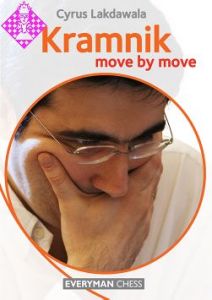 Kramnik: Move by Move24,95 €
Kramnik: Move by Move24,95 € -
 The Slav - move by move24,50 €
The Slav - move by move24,50 € - Mehr von Everyman

